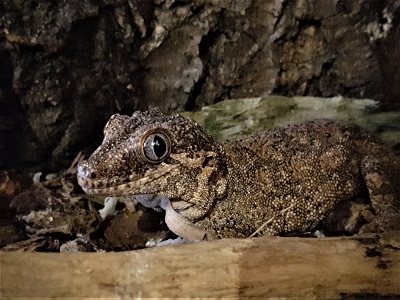
February is such a short month that it doesn’t feel like we’ve had enough time with our Animal of the Month, the gargoyle gecko. But it’s time to bid our striking featured creature a fond farewell for now. We hope that you enjoyed following us on Twitter @ExoticPetVets as we tweeted about gargoyle geckos all month long. But if you missed any of our tweets, you can find a summary of them right here. Did you know?:
- The gargoyle gecko (Rhacodactylus auriculatus) is a nocturnal gecko species endemic to New Calendonia, an archipelago east of Australia.
- Gargoyle geckos are also commonly known as the knob-headed giant gecko and the New Caledonia bumpy gecko. All of these common names are a nod to the two small bumps on their heads which look like horns or ears.
- Part of the gargoyle gecko’s scientific name is also in recognition of these two cranial bumps – “auriculatus” means “eared” in Latin.
- Gargoyle geckos are a medium-sized gecko with heavy-set bodies. They measure an average of between 7”-10” (17-25 cms), with about 3” (7 cms) of that being tail length. Their tails are thin and prehensile, meaning they can use their tails to grip things.
- Gargoyle geckos have five toes on each foot and each toe has a small claw, which helps them climb trees and other rough surfaces. While they do have small toe pads, they don’t have the ability to climb up smooth surfaces like glass.
- The physical characteristic gargoyle geckos are most famous for is the two small bumps on their head, which are actually a part of the parietal bone of their skulls.
- Gargoyle geckos have a small, but protruding snout which gives their heads a triangular shape. They also have big round eyes. They don’t have external ears. The holes behind either side of their mouths are the openings for their ears.
- Gargoyle geckos can be seen sporting a wide variety of colour patterns, including red, grey, brown, orange and white. They can also have stripes, blotches or a mottled appearance.
- When they feel threatened, gargoyle geckos have the ability to drop their tails. And when they do, their tails thrash around independently which can confuse a predator long enough to allow the gecko to escape.
- Gargoyle geckos can be aggressive towards each other and are known for picking off each other’s tails, which they will likely also eat.
- Unlike crested geckos, gargoyle geckos do have the ability to regrow their tails. The new tail will look almost exactly like the original tail, the only difference being in the scalation (the arrangement of scales).
- Predators of gargoyle geckos include birds of prey along with animals introduced to New Caledonia’s main island such as rats, cats and dogs. They also face the human threats of habitat destruction and poaching for the illegal pet trade.
- Valentine’s Day is a notable day in February, but there is little romance when it comes to the mating habits of gargoyle geckos.
- Gargoyle geckos reach sexual maturity between 15-18 months of age. Their mating behaviour can be rough with biting and tail loss being common occurrences. They will also vocalize with chirping and grumbling.
- Female gargoyle geckos will typically lay two eggs several weeks after mating. They will bury the eggs and approximately 70 to 90 days later, the hatchlings will emerge from their eggs. The egg laying can repeat up to 10 times.
- Gargoyle geckos don’t have eyelids so they can’t close their eyes. Instead each eye has a transparent scale called a spectacle over it in order to protect and moisten their eyes.
- Gargoyle geckos will lick their eyeballs to keep them clean.
- Much of what is known about gargoyle geckos is based on observations of captive animals. The number of studies documenting their wild counterparts is limited.
- Gargoyle geckos have a small range in the wild. In New Caledonia, they are only found on the archelago’s biggest and main island, Grande Terre, which is 16,664 square kms.
- There are reports of isolated populations of gargoyle geckos being spotted in more northern parts of Grande Terre, but for the most part they are found in just the southern third of the island.
- In the wild, gargoyle geckos live in humid forests and in thickets. They are primarily arboreal, meaning they spend much of their time in the branches of trees and shrubs.
- Gargoyle geckos can also be found on the ground foraging for food and when it’s time to mate.
- Compared to other gecko species, gargoyle geckos enjoy a wide variety of food in their diet. They are omnivorous, meaning they eat both plant and animal matter.
- The foods gargoyle geckos enjoy in the wild include flowers and other plant material, sap, mollusks, many different types of arthropods (insects, spiders, etc.) and even small lizards and skinks.
- Like all other reptiles, gargoyle geckos will shed their skin regularly as they grow. They will remove their shedding skin off by chewing, licking and rubbing it off their bodies.
- Gargoyle geckos will eat their entire shedded skin. This not only gives them extra nutrients, but it also helps hide evidence of their presence from predators.
- There isn’t much data available on how long gargoyle geckos live in the wild, but some sources suggest that they live for an average of 10-15 years.
- With proper care in captivity, gargoyle geckos can live between 15-20 years on average.

